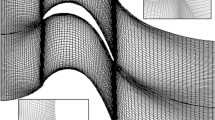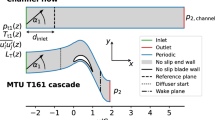Abstract
The aim of this paper is to predict the phenomenon of laminar separation, transition and reattachment in a low-pressure turbine (LPT). Self-developed large eddy simulation program of compressible N-S equations was used to describe the flow structures of T106A LPT blade profile at Reynolds number of 1.1×105 based on the exit isentropic velocity and chord length. The computational results show the distributions of time-averaged wall-static pressure coefficient and mean skin-friction coefficient on the blade surface. The locations of laminar separation and reattachment points occur around 87% and 98% axial chord, which agree well with experiment data. The two-dimensional shear layer is gradually unstable along the downstream half of the suction side as a result of the spanwise fluctuation and the roll up of shear layer via Kelvin-Helmholtz (KH) instability. Three-dimensional motions appear near 84% axial chord which later triggers spanwise vortexes and streamwise vortexes, leading to transition to turbulence in the separation bubble. Through introducing the concept of dissipation function, the high loss mainly comes from the places where strong shear layer and intense fluctuation exist. Furthermore, the separation region is only an accumulation center of the low-energy fluid rather than an area of loss source.
Similar content being viewed by others
References
Pacciani R, Marconcini M, Fadai-Ghotbi A, et al. Calculation of high-lift cascades in low pressure turbine conditions using a three-equation model. ASME J Turbomach, 2011, 133: 031016–1-9
Howell R J. Wake-separation Bubble Interactions in Low Reynolds Number Turbomachinery. Dissertation of Doctoral Degree. Cambridge: Cambridge University, 1999
Tyacke J, Tucker P, Jefferson-Loveday R, et al. LES for turbines: Methodologies, cost and future outlooks. ASME Paper, 2013, GT2013–94416
Huang J H. Separation control over low pressure turbine blades using plasma actuators. Dissertation of Doctoral Degree. Iniana: The University of Notre Dame, 2005
Durbin P A. On the k-ɛ stagnation point anomaly. IJHFF, 1996, 17: 89–90
Menter F R, Langtry R B, Likki S R, et al. A correlation-based transition model using local variables-part I: Model formulation. ASME J Turbomach, 2006, 128: 413–422
Langtry R B, Menter F R, Likki S R, et al. A correlation-based transition model using local variables-part II: Test cases and industrial applicatoins. ASME J Turbomach, 2006, 128: 423–434
Suzen Y B, Huang P G, Ashpis D E, et al. A computational fluid dynamics study of transitional flows in low-pressure turbines under a wide range of operating conditions. ASME J Turbomach, 2007, 129: 527–541
Mayle R E. The role of laminar turbulent transition in gas turbine engines. ASME J Turbomach, 1991, 113: 509–537
Engber M, Fottner L. The effect of incoming wakes on boundary layer transition of a highly loaded turbine cascade. AGARD, 1995, CP-517
Fujiwara H, Voke P R, Arakawa C. LES of TL10 LP turbine blade row. In: Proceedings of the 5th International Symposium on Engineering Turbulence Modelling and Experiments. Mallorca, 2002
Karimi M, Paraschivoiu M. Comparison of large eddy simulation methods for flows over gas turbine blades. ASME Paper, 2007, 2007-GT-27410
Raverdy B, Mary I, Sagaut P, et al. High-resolution large-eddy simulation of flow around low-pressure turbine blade. AIAA J, 2003, 41: 390–397
Wissink J G, Rodi W. Direct numerical simulations of transitional flow in turbomachinery. ASME J Turbomach, 2006, 128: 668–678
Sarkar S. Identification of flow structures on a LP turbine blade due to periodic passing wakes. ASME J Turbomach, 2008, 130: 061103–1-10
Tucker P. Computation of unsteady turbomachinery flows: Part 2 LES and hybrids. Prog Aerosp Sci, 2011, 47: 546–569
Bocquet S, Sagaut P, Jouhaud J. A compressible wall model for large-eddy simulation with application to prediction of aerothermal quantities. Phys Fluids, 2012, 24: 065103
Zhang D, Shu J, Lan J B, et al. Large-eddy simulation of boundary layer separation and reattachment in low-pressure turbine cascade (in Chinese). Pro CSEE, 2009, 29: 77–83
D’Ovidio A, Harkins J A, Gostelow J P. Turbulent spot in strong adverse pressure gradient: Part 1-spot behaviour. ASME Paper, 2001, 2001-GT-0194
D’Ovidio A, Harkins J A, Gostelow J P. Turbulent spot in strong adverse pressure gradient: Part 2-spot propagation and spreading rates. ASME Paper, 2001, 2001-GT-0407
Hodson H. Turbulence modelling for unsteady flows in axial turbine: turmunsflat. Brite-Euram Project, 2000, Final TR CT96-1043: 85–99
Wissink J G. DNS of separating, low reynolds number flow in a turbine cascade with incoming wakes. Int J Heat Fluid Flow, 2003, 24: 626–635
Sarkar S, Voke P R. Large-eddy simulation of unsteady surface pressure over a lp turbine due to interactions of passing wakes and inflexional boundary layer. ASME J Turbomach, 2006, 128: 221–231
Stieger R, Hollis D, Hodson H. Unsteady surface pressures due to wake induced transition in laminar separation bubble on a lp turbine cascade. ASME Paper, 2003, GT2003-38303
Germano M. Turbulence: the filtering approach. J Fluid Mech, 1992, 238: 325–336
Lilly D K. A proposed modification of the Germano subgrid-scale closure method. Phys Fluid A, 1992, 4: 633–635
Verman B, Geurts B, Kuerten H. A priori tests of large eddy simulation of compressible plane mixing layer. J Eng Math, 1995, 29: 299–327
Knight D, Zhou G, Okong’o N, et al. Compressible large eddy simulation using unstructured grids. AIAA Paper, 1988, AIAA-98-0535
Mittal R, Moin P. Suitability of upwind-biased finite-difference schemes for large-eddy simulation of turbulent flows. AIAA J, 1997, 35: 1415–1417
Ducros F, Laporte F, Soulères T, et al. High-order fluxes for conservative skew-symmetric-like schemes in structured meshes: Application to compressible flows. J Computational Phys, 2000, 116: 114–139
Blazek J. Computational Fluid Dynamics: Principles and Applications. 2nd eds. Amsterdam: Elsevier, 2005
Turkel E, Vatsa V N. Effect of artificial viscosity on three-dimensional flow solutions. AIAA J, 1994, 32: 39–45
Stadtmüller P. Investigation of wake-induced transition on the LP turbine cascade T106 A-EIZ. Technical Report, University of the Armed Forces Munich. 2002
Sandberg R D, Pichler R, Chen L. Assessing the sensitivity of turbine cascade flow to inflow disturbances using direct numerical simulation. In: 13th International Symposium for Unsteady Aerodynamics, Aeroacoustics and Aeroelasticity in Turbomachinery (ISUAAAT). Tokyo, 2012
Yang Z, Voke P R. Large eddy simulation of boundary layer separation and transition at a change of surface curvature. J Fluid Mech, 2001, 439: 305–333
Spalart P, Strelets M. Mechanisms of transition and heat transfer in a separation bubble. J Fluid Mech, 2000, 403: 329–349
Author information
Authors and Affiliations
Corresponding author
Rights and permissions
About this article
Cite this article
Wang, Y., Chen, F., Liu, H. et al. Large eddy simulation of unsteady transitional flow on the low-pressure turbine blade. Sci. China Technol. Sci. 57, 1761–1768 (2014). https://doi.org/10.1007/s11431-014-5626-x
Received:
Accepted:
Published:
Issue Date:
DOI: https://doi.org/10.1007/s11431-014-5626-x




